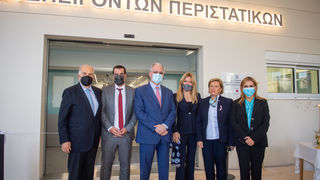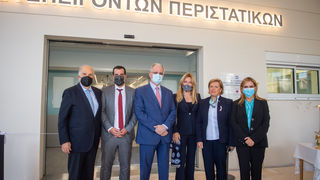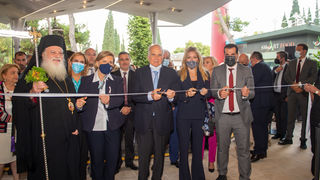Inauguration of Donation for the Refurbishing – Renovation – Upgrading of the Emergency Department of General Hospital of Athens ''G. GENNIMATAS''

On Wednesday 12 October 2022, the project “Refurbishing – Renovation – Upgrading of the Emergency Department” of General Hospital of Athens “G. Gennimatas”, which was implemented following a donation from the John S. Latsis Public Benefit Foundation, was inaugurated in the presence of the President of the Hellenic Parliament, Mr. Kostas Tasoulas, and the entire political leadership of the Ministry of Health. The project is expected to contribute significantly to the modernisation of the hospital’s emergency care services, to the provision of a more efficient assistance to patients and their companions, as well as to the improvement of working conditions for the hospital staff.
The E.D. of General Hospital “G. Gennimatas” was launched as the first emergency coordination centre in the late 1960s in order to deal with all emergency cases within the Attica basin and the entire Greek territory on a 24-hour daily basis. Over 80,000 people visited the E.D. of General Hospital “G. Gennimatas” during its on-call operation for 2021, making it the most frequently visited hospital in the Attica basin; attendance reached approximately 55,000 people for the first half of 2022.
The donation of the John S. Latsis Public Benefit Foundation focused on the design and implementation of a complete rebuilding, at construction and electrical/mechanical level, of the entire E.D. building complex (1,192 m2), its surrounding area (1,600 m2) and the new canopy (350 m2), as well as the supply and installation of state-of-the art medical technology and other equipment.
The functional and spatial redesign of the E.D. ensures its smooth operation and increases the hopsital’s efficiency, with a view to meeting modern healthcare needs.
After thanking both the John S. Latsis Public Benefit Foundation for its funding of the project “Refurbishing – Renovation – Upgrading of the Emergency Department” of the Hospital and the Minister of Health, Mr Thanos Plevris, for his contribution to the implementation of the project, Mr Eleftherios Boulias, Director of General Hospital “G. Gennimatas”, referred to the project’s benefits for patients and health professionals, noting in particular that:
“The upgrading of the Emergency Department of the Hospital, operating in the patients’ interest and for the patients’ safety, regardless of their socio-economic status, enables us to pursue:
- an early diagnosis of a patient’s health problem;
- its effective treatment;
- the provision of high quality care;
- providing such care promptly and efficiently; and
- developing and contributing to the progress of medical research, training and specialisation of medical staff.
This project will also greatly benefit all health professionals in the Hospital. Through the donation we aim to:
- ensure their safety;
- create the necessary conditions for them to carry out their work efficiently;
- offer them a decent work environment;
- gain the respect and trust of patients and their families in the performance of our health professionals’ work.”
In his address, Dr Petros Kalantzis, Chairman of the Executive Board at the John S. Latsis Public Benefit Foundation, stated that:
“This donation forms part of a bundle of actions we announced back in 2018 in response to the nationwide tragedy caused by the wildfires in Mati. In particular, we designed and implemented a mix of targeted interventions in the health sector, hoping that these will contribute in the medium to long term to the preparedness for and timely response to similar emergencies. As such, this programme has been mostly directed towards meeting needs related to emergency management. After all, the health sector is a critical link that runs horizontally through the Civil Protection and management chain in respect of any emergency situation.
Thus, after having investigated and prioritized existing needs together with the heads of the competent Health Regions of Attica, the Directors of Hospitals of Attica and in collaboration with representatives of the competent institutions of the Greek State, in the course of these years we have made some important donations that have already been included in the National Health System.
In particular:
- We have funded the upgrade of the medical technology equipment of the Emergency Department at KAT Hospital, as well as the upgrade of the 2nd Intensive Care Unit and the creation of a High Dependency Unit in that same hospital.
- We have funded the modernisation of the medical technology equipment of the Emergency Department at “Thriasio” General Hospital of Eleusis and the Intensive Care Unit of the Latsio Burn Centre.
- We have provided equipment to cover the needs of fixed rooms and mobile blood collection teams of the Hellenic National Blood Donation Centre.
- Our most important contribution in the framework of this programme, however, has been funding the study and implementation of the project for the Refurbishing, Renovation and Upgrading of the Emergency Department of General Hospital of Athens ‘G. Gennimatas’, which it is our great pleasure and honour to inaugurate today.
We, at the Latsis Foundation, firmly believe that any contribution to the work of the State aimed at improving the infrastructure and equipment of Greek hospitals is a duty incumbent upon us all. A duty that we have consistently been serving for decades, thus remaining faithful to John Latsis’ values and principles of social contribution.”
The Minister of Health, Mr Thanos Plevris, made the following statement:
"We would like to thank Μs Marianna Latsis for the contribution of the Latsis family and the Foundation to a Hospital that, suffice it to say, has received 80,000 visits for 2021 and 54,000 visits in the first half of 2022. But besides thanking the Foundation, it is important to mention that with the 350 million secured from the Recovery Fund, 80 hospitals in the National Health System will benefit from building restructuring works. And indeed, hospitals do not only consist in the buildings and equipment for which funds have been secured; they are the women and men who serve the National Health System and whom we have right here before us. Dear doctors and nurses, we are supporting the National Health System by advertising 6,000 posts, trying to provide incentives in a very difficult environment to keep doctors in the National Health System. Step by step, problems will be solved; step by step, the image of the National Health System will change.”
The Deputy Minister of Health, Ms Mina Ganga, noted, among other things:
“Thank you very much, Mrs Latsis, Mr Kalantzis. Let me tell you that this is my third time as Deputy Minister in charge of hospitals that I have come to the hospital for the E.D. I want to praise the great assistance of the entire staff and the administration, but especially of my colleagues and the director of the 1st Health Region, as well as the deputy directors, in getting this done, while ensuring that the hospital, which often receives more patients compared to all other hospitals in Greece during on-call days, could still be operative. So, the first ‘thank you’ goes to all my fellow health professionals who are here and treat patients every day, coping valiantly, working hard. The pandemic has exhausted everyone's capacity and yet they are all here and they are working”.
She added that
“I want to mention that this building was built as a ‘house for Sotiria sisters’ before the war. In order to prevent its occupation by the Germans, the then director of ‘Sotiria’ Hospital brought in 2-3 haemoptysis patients to walk in the corridors so that the Germans would not enter. This is how he saved this building, which then became part of the General State Hospital; and it is really operative, offering excellent services to everyone, ever since it became a key element of the National Health system in the latter's dawn. It is therefore a very, very crucial hospital with a crucial E.D., perhaps the most crucial one in Greece along with those of ‘Evangelismos’ and ‘Hippokrateio’ hospitals.
Note to Editors:
The Operational Layout of the New Emergency Department Complex, which is being delivered to the Hospital, is the product of months of collaboration between the Project Designers and the Hospital Representatives –the Administration, the Department Director, the Director of Medical Services, the Technical Department, the Medical and Nursing Staff, the Biomedical Equipment Department, etc.; it has been designed in accordance with the current legislation and the specifications of the Ministry of Health.
The main objectives of the study for the design of the new E.D. were, among others:
- to solve all the existing operational problems of the E.D.;
- to ensure a clear separation of patients and companions – visitors;
- to ensure that there are adequate examination and operations areas for the provision of a proper and prompt assistance to patients;
- to provide all the required support spaces for the proper functioning of the Department and for the convenience of the Medical and Nursing Staff;
- to elevate the access road at the entrance of the E.D. (removing the existing 14% slope ramp) to facilitate and ensure level access for ambulances, sedentary patients, wheelchair patients and users of any type of roll stand or trolley;
- to design a new metal canopy at the E.D. entrance that aesthetically marks the Department and protects the movement of patients, visitors, ambulances, vehicles, trolleys, etc. from the weather.
- to design and install an entirely new cooling/heating system, which will be supplied by the existing central networks of the hospital but, with the installation of a central air conditioning unit equipped with energy-saving and automatic control systems, will create the appropriate temperature conditions in the rooms regardless of the external conditions and will achieve the necessary ventilation of the rooms, while reducing energy costs compared to the existing central air conditioning system.
In detail, the new layout of the E.D. is as follows:
1) MAIN ENTRANCE
- Patient Reception area with an Information area.
- Accounting area – Cashier's office – Patient Service Secretariat.
- Waiting area for ambulatory patients and companions, with W.C. areas (male-female).
- Social worker's Office – Patients Advice and Liaison Service.
- Triage area – 5 beds.
2) EXAMINATION AREAS – SUPPORTING AREAS
- Cardiology Department – Resuscitation: 5 beds
- Pathology Department: 12 beds
- Isolation: 1 bed
- Surgery Department: 9 beds
- Plaster room
- Electrocardiograph area with W.C.
- Waiting area for recumbent patients with a capacity of 10 beds
- Waiting area for ambulatory patients
- Patient W.C. (male-female and persons with disabilities)
- Patient washroom
- Staff areas (Offices, Changing Rooms – W.C., on-call rooms)
- Cleaning room
- Sluice room
- Storage areas
- Computer facilities areas
3) MINOR OPERATIONS DEPARTMENT
- 3 microsurgery rooms
- Scrub-up area (for Doctors - Nurses)
- Sterile material room
- Sterilisation – tool washing area
- Dirty utility room





